check engine VOLVO XC90 TWIN ENGINE 2019 Owners Manual
[x] Cancel search | Manufacturer: VOLVO, Model Year: 2019, Model line: XC90 TWIN ENGINE, Model: VOLVO XC90 TWIN ENGINE 2019Pages: 697, PDF Size: 10.33 MB
Page 12 of 697
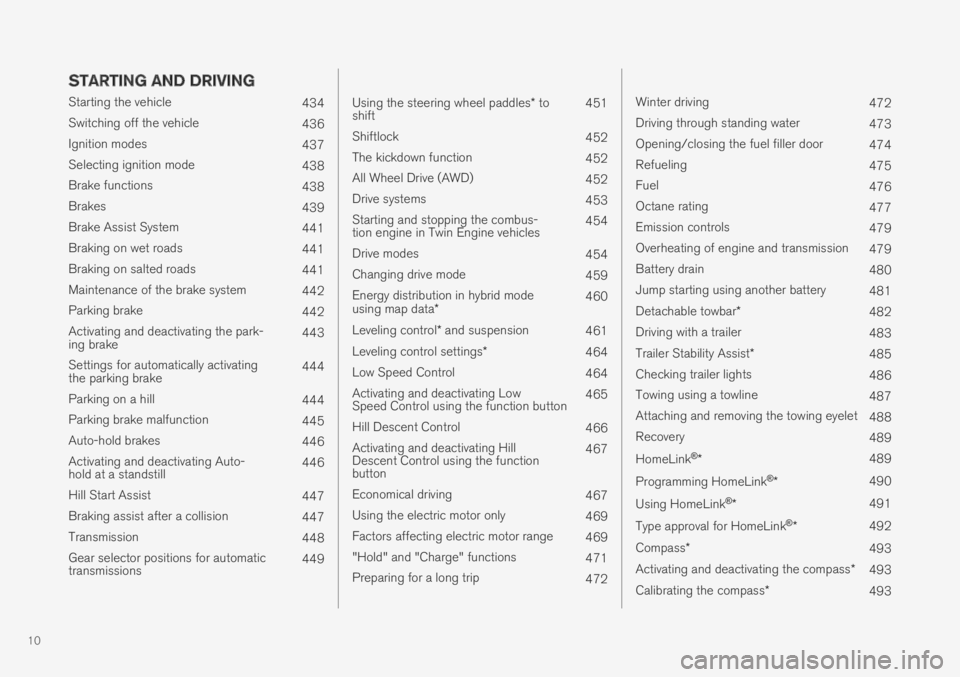
10
STARTING AND DRIVING
Starting the vehicle434
Switching off the vehicle436
Ignition modes437
Selecting ignition mode438
Brake functions438
Brakes439
Brake Assist System441
Braking on wet roads441
Braking on salted roads441
Maintenance of the brake system442
Parking brake442
Activating and deactivating the park-ing brake443
Settings for automatically activatingthe parking brake444
Parking on a hill444
Parking brake malfunction445
Auto-hold brakes446
Activating and deactivating Auto-hold at a standstill446
Hill Start Assist447
Braking assist after a collision447
Transmission448
Gear selector positions for automatictransmissions449
Using the steering wheel paddles* toshift451
Shiftlock452
The kickdown function452
All Wheel Drive (AWD)452
Drive systems453
Starting and stopping the combus-tion engine in Twin Engine vehicles454
Drive modes454
Changing drive mode459
Energy distribution in hybrid modeusing map data*460
Leveling control* and suspension461
Leveling control settings*464
Low Speed Control464
Activating and deactivating LowSpeed Control using the function button465
Hill Descent Control466
Activating and deactivating HillDescent Control using the functionbutton
467
Economical driving467
Using the electric motor only469
Factors affecting electric motor range469
"Hold" and "Charge" functions471
Preparing for a long trip472
Winter driving472
Driving through standing water473
Opening/closing the fuel filler door474
Refueling475
Fuel476
Octane rating477
Emission controls479
Overheating of engine and transmission479
Battery drain480
Jump starting using another battery481
Detachable towbar*482
Driving with a trailer483
Trailer Stability Assist*485
Checking trailer lights486
Towing using a towline487
Attaching and removing the towing eyelet488
Recovery489
HomeLink®*489
Programming HomeLink®*490
Using HomeLink®*491
Type approval for HomeLink®*492
Compass*493
Activating and deactivating the compass*493
Calibrating the compass*493
Page 15 of 697
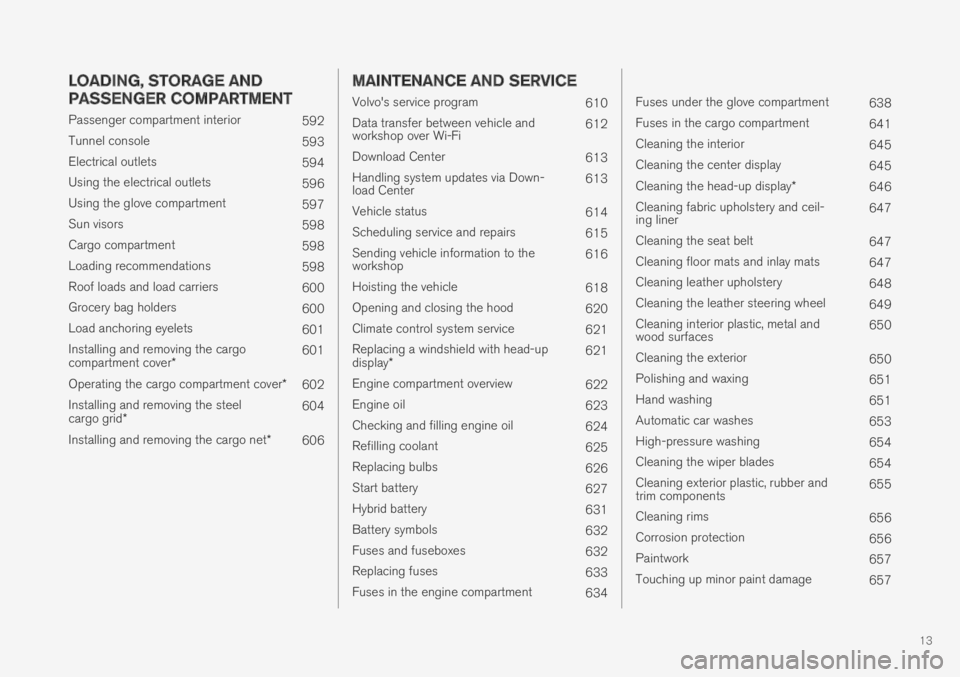
13
LOADING, STORAGE AND
PASSENGER COMPARTMENT
Passenger compartment interior592
Tunnel console593
Electrical outlets594
Using the electrical outlets596
Using the glove compartment597
Sun visors598
Cargo compartment598
Loading recommendations598
Roof loads and load carriers600
Grocery bag holders600
Load anchoring eyelets601
Installing and removing the cargocompartment cover*601
Operating the cargo compartment cover*602
Installing and removing the steelcargo grid*604
Installing and removing the cargo net*606
MAINTENANCE AND SERVICE
Volvo's service program610
Data transfer between vehicle andworkshop over Wi-Fi612
Download Center613
Handling system updates via Down-load Center613
Vehicle status614
Scheduling service and repairs615
Sending vehicle information to theworkshop616
Hoisting the vehicle618
Opening and closing the hood620
Climate control system service621
Replacing a windshield with head-updisplay*621
Engine compartment overview622
Engine oil623
Checking and filling engine oil624
Refilling coolant625
Replacing bulbs626
Start battery627
Hybrid battery631
Battery symbols632
Fuses and fuseboxes632
Replacing fuses633
Fuses in the engine compartment634
Fuses under the glove compartment638
Fuses in the cargo compartment641
Cleaning the interior645
Cleaning the center display645
Cleaning the head-up display*646
Cleaning fabric upholstery and ceil-ing liner647
Cleaning the seat belt647
Cleaning floor mats and inlay mats647
Cleaning leather upholstery648
Cleaning the leather steering wheel649
Cleaning interior plastic, metal andwood surfaces650
Cleaning the exterior650
Polishing and waxing651
Hand washing651
Automatic car washes653
High-pressure washing654
Cleaning the wiper blades654
Cleaning exterior plastic, rubber andtrim components655
Cleaning rims656
Corrosion protection656
Paintwork657
Touching up minor paint damage657
Page 30 of 697
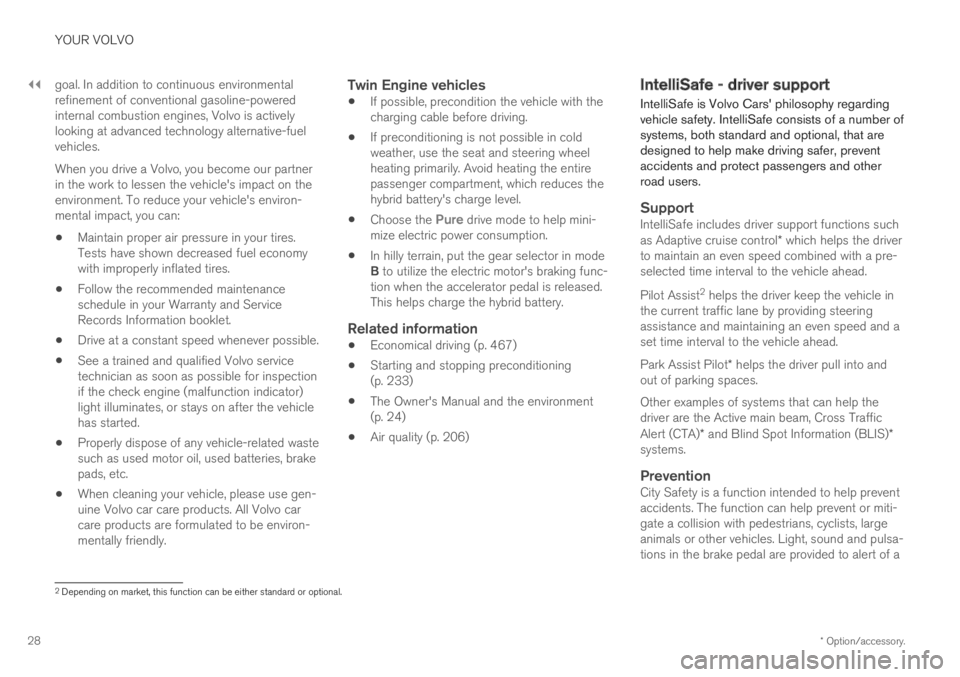
||
YOUR VOLVO
* Option/accessory.28
goal. In addition to continuous environmentalrefinement of conventional gasoline-poweredinternal combustion engines, Volvo is activelylooking at advanced technology alternative-fuelvehicles.
When you drive a Volvo, you become our partnerin the work to lessen the vehicle's impact on theenvironment. To reduce your vehicle's environ-mental impact, you can:
Maintain proper air pressure in your tires.Tests have shown decreased fuel economywith improperly inflated tires.
Follow the recommended maintenanceschedule in your Warranty and ServiceRecords Information booklet.
Drive at a constant speed whenever possible.
See a trained and qualified Volvo servicetechnician as soon as possible for inspectionif the check engine (malfunction indicator)light illuminates, or stays on after the vehiclehas started.
Properly dispose of any vehicle-related wastesuch as used motor oil, used batteries, brakepads, etc.
When cleaning your vehicle, please use gen-uine Volvo car care products. All Volvo carcare products are formulated to be environ-mentally friendly.
Twin Engine vehicles
If possible, precondition the vehicle with thecharging cable before driving.
If preconditioning is not possible in coldweather, use the seat and steering wheelheating primarily. Avoid heating the entirepassenger compartment, which reduces thehybrid battery's charge level.
Choose the Pure drive mode to help mini-mize electric power consumption.
In hilly terrain, put the gear selector in modeB to utilize the electric motor's braking func-tion when the accelerator pedal is released.This helps charge the hybrid battery.
Related information
Economical driving (p. 467)
Starting and stopping preconditioning(p. 233)
The Owner's Manual and the environment(p. 24)
Air quality (p. 206)
IntelliSafe - driver support
IntelliSafe is Volvo Cars' philosophy regardingvehicle safety. IntelliSafe consists of a number ofsystems, both standard and optional, that aredesigned to help make driving safer, preventaccidents and protect passengers and otherroad users.
Support
IntelliSafe includes driver support functions suchas Adaptive cruise control* which helps the driverto maintain an even speed combined with a pre-selected time interval to the vehicle ahead.
Pilot Assist2 helps the driver keep the vehicle inthe current traffic lane by providing steeringassistance and maintaining an even speed and aset time interval to the vehicle ahead.
Park Assist Pilot* helps the driver pull into andout of parking spaces.
Other examples of systems that can help thedriver are the Active main beam, Cross TrafficAlert (CTA)* and Blind Spot Information (BLIS)*systems.
Prevention
City Safety is a function intended to help preventaccidents. The function can help prevent or miti-gate a collision with pedestrians, cyclists, largeanimals or other vehicles. Light, sound and pulsa-tions in the brake pedal are provided to alert of a
2Depending on market, this function can be either standard or optional.
Page 64 of 697
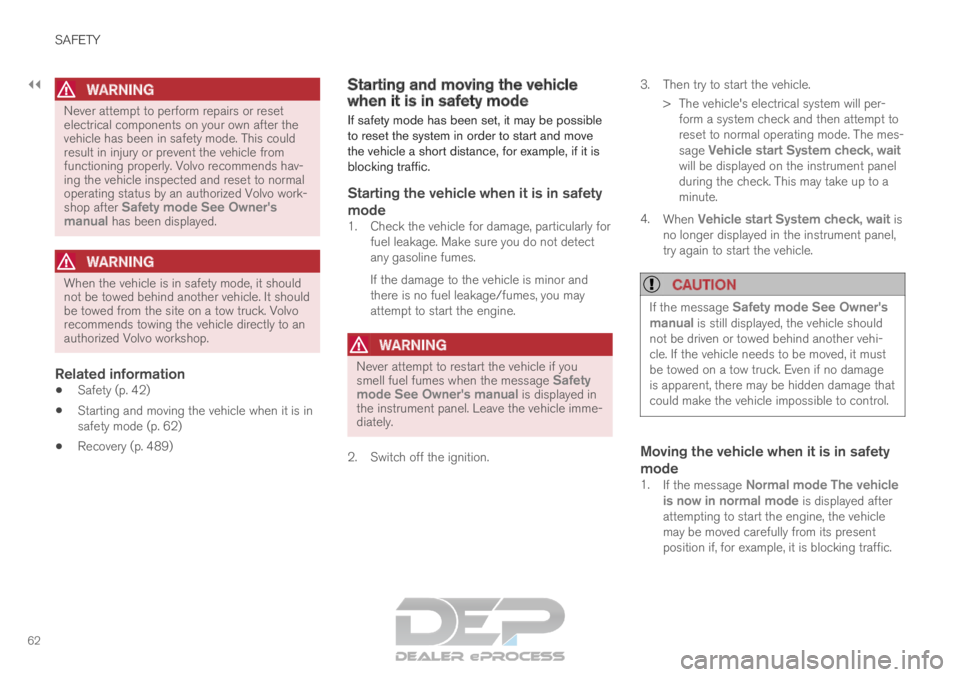
||SAFETY
62
WARNING
Never attempt to perform repairs or reset
electrical components on your own after the
vehicle has been in safety mode. This could
result in injury or prevent the vehicle from
functioning properly. Volvo recommends hav-
ing the vehicle inspected and reset to normal
operating status by an authorized Volvo work-
shop after
Safety mode See Owner's
manual has been displayed.
WARNING When the vehicle is in safety mode, it should
not be towed behind another vehicle. It should
be towed from the site on a tow truck. Volvo
recommends towing the vehicle directly to an
authorized Volvo workshop.
Related information
Safety (p. 42)
Starting and moving the vehicle when it is in
safety mode (p. 62)
Recovery (p. 489) Starting and moving the vehicle
when it is in safety mode
If safety mode has been set, it may be possible
to reset the system in order to start and move
the vehicle a short distance, for example, if it is
blocking traffic.
Starting the vehicle when it is in safety
mode
1. Check the vehicle for damage, particularly for
fuel leakage. Make sure you do not detect
any gasoline fumes.
If the damage to the vehicle is minor and
there is no fuel leakage/fumes, you may
attempt to start the engine.
WARNING Never attempt to restart the vehicle if you
smell fuel fumes when the message
Safety
mode See Owner's manual is displayed in the instrument panel. Leave the vehicle imme-
diately.
2.
Switch off the ignition. 3. Then try to start the vehicle.
> The vehicle's electrical system will per-form a system check and then attempt to
reset to normal operating mode. The mes-
sage Vehicle start System check, wait
will be displayed on the instrument panel
during the check. This may take up to a
minute.
4. When Vehicle start System check, wait is
no longer displayed in the instrument panel,
try again to start the vehicle.
CAUTION If the message
Safety mode See Owner's
manual is still displayed, the vehicle should not be driven or towed behind another vehi-
cle. If the vehicle needs to be moved, it must
be towed on a tow truck. Even if no damage
is apparent, there may be hidden damage that
could make the vehicle impossible to control.
Moving the vehicle when it is in safety
mode
1. If the message Normal mode The vehicle
is now in normal mode is displayed after
attempting to start the engine, the vehicle
may be moved carefully from its present
position if, for example, it is blocking traffic.
Page 97 of 697
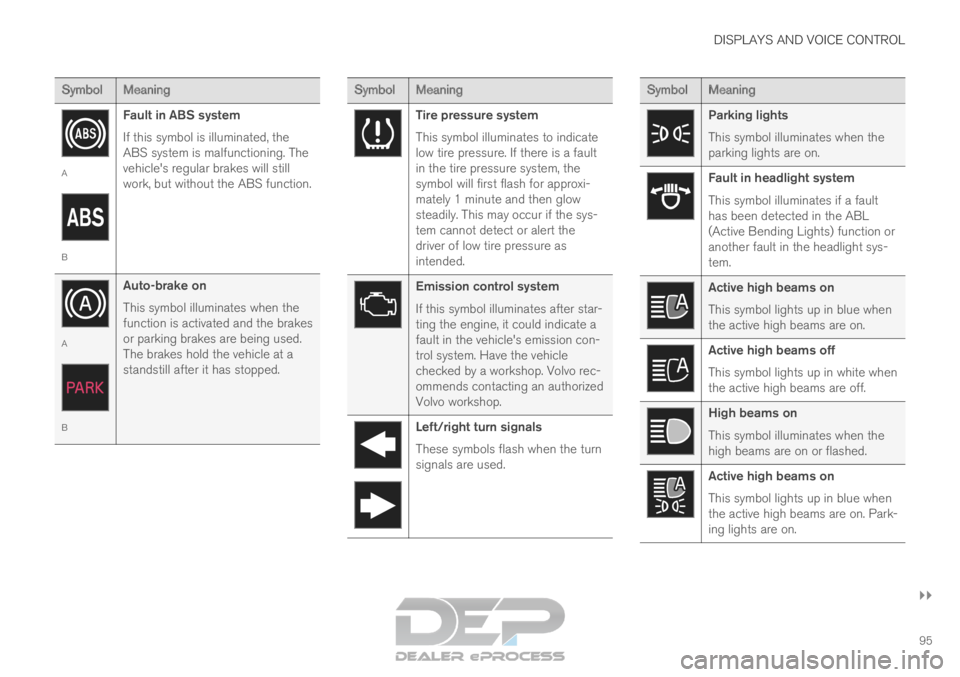
DISPLAYS AND VOICE CONTROL
}}95 Symbol
Meaning A
B
Fault in ABS system
If this symbol is illuminated, the
ABS system is malfunctioning. The
vehicle's regular brakes will still
work, but without the ABS function. A
B
Auto-brake on
This symbol illuminates when the
function is activated and the brakes
or parking brakes are being used.
The brakes hold the vehicle at a
standstill after it has stopped. Symbol
Meaning Tire pressure system
This symbol illuminates to indicate
low tire pressure. If there is a fault
in the tire pressure system, the
symbol will first flash for approxi-
mately 1 minute and then glow
steadily. This may occur if the sys-
tem cannot detect or alert the
driver of low tire pressure as
intended.
Emission control system
If this symbol illuminates after star-
ting the engine, it could indicate a
fault in the vehicle's emission con-
trol system. Have the vehicle
checked by a workshop. Volvo rec-
ommends contacting an authorized
Volvo workshop.
Left/right turn signals
These symbols flash when the turn
signals are used. Symbol
Meaning Parking lights
This symbol illuminates when the
parking lights are on.
Fault in headlight system
This symbol illuminates if a fault
has been detected in the ABL
(Active Bending Lights) function or
another fault in the headlight sys-
tem.
Active high beams on
This symbol lights up in blue when
the active high beams are on.
Active high beams off
This symbol lights up in white when
the active high beams are off.
High beams on
This symbol illuminates when the
high beams are on or flashed.
Active high beams on
This symbol lights up in blue when
the active high beams are on. Park-
ing lights are on.
Page 99 of 697
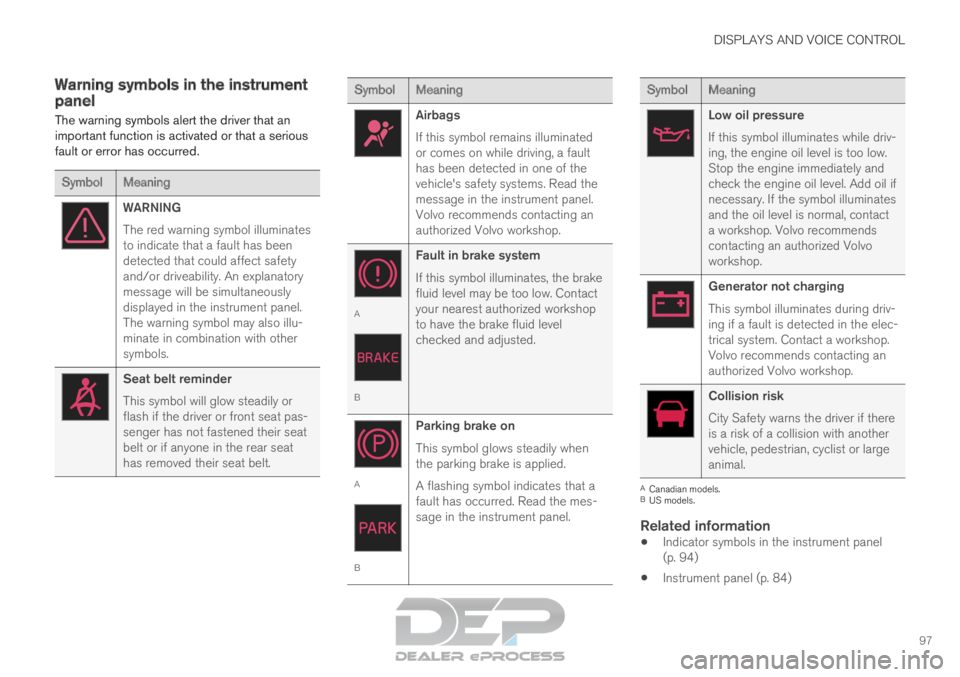
DISPLAYS AND VOICE CONTROL
97
Warning symbols in the instrument
panel
The warning symbols alert the driver that an
important function is activated or that a serious
fault or error has occurred. Symbol
Meaning WARNING
The red warning symbol illuminates
to indicate that a fault has been
detected that could affect safety
and/or driveability. An explanatory
message will be simultaneously
displayed in the instrument panel.
The warning symbol may also illu-
minate in combination with other
symbols.
Seat belt reminder
This symbol will glow steadily or
flash if the driver or front seat pas-
senger has not fastened their seat
belt or if anyone in the rear seat
has removed their seat belt. Symbol
Meaning Airbags
If this symbol remains illuminated
or comes on while driving, a fault
has been detected in one of the
vehicle's safety systems. Read the
message in the instrument panel.
Volvo recommends contacting an
authorized Volvo workshop.
A
B
Fault in brake system
If this symbol illuminates, the brake
fluid level may be too low. Contact
your nearest authorized workshop
to have the brake fluid level
checked and adjusted. A
BParking brake on
This symbol glows steadily when
the parking brake is applied.
A flashing symbol indicates that a
fault has occurred. Read the mes-
sage in the instrument panel. Symbol
Meaning Low oil pressure
If this symbol illuminates while driv-
ing, the engine oil level is too low.
Stop the engine immediately and
check the engine oil level. Add oil if
necessary. If the symbol illuminates
and the oil level is normal, contact
a workshop. Volvo recommends
contacting an authorized Volvo
workshop.
Generator not charging
This symbol illuminates during driv-
ing if a fault is detected in the elec-
trical system. Contact a workshop.
Volvo recommends contacting an
authorized Volvo workshop.
Collision risk
City Safety warns the driver if there
is a risk of a collision with another
vehicle, pedestrian, cyclist or large
animal.
A
Canadian models.
B US models.
Related information
Indicator symbols in the instrument panel
(p. 94)
Instrument panel (p. 84)
Page 199 of 697
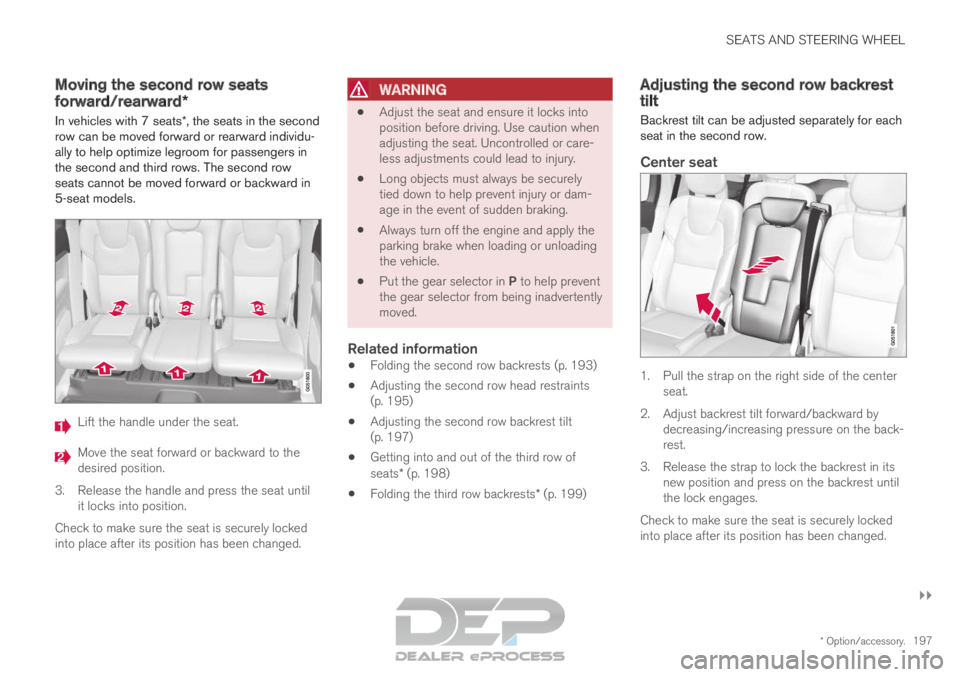
SEATS AND STEERING WHEEL
}}
* Option/accessory. 197
Moving the second row seats
forward/rearward*
In vehicles with 7 seats*, the seats in the second
row can be moved forward or rearward individu-
ally to help optimize legroom for passengers in
the second and third rows. The second row
seats cannot be moved forward or backward in
5-seat models. Lift the handle under the seat.
Move the seat forward or backward to the
desired position.
3.
Release the handle and press the seat until
it locks into position.
Check to make sure the seat is securely locked
into place after its position has been changed.
WARNING
Adjust the seat and ensure it locks into
position before driving. Use caution when
adjusting the seat. Uncontrolled or care-
less adjustments could lead to injury.
Long objects must always be securely
tied down to help prevent injury or dam-
age in the event of sudden braking.
Always turn off the engine and apply the
parking brake when loading or unloading
the vehicle.
Put the gear selector in P to help prevent
the gear selector from being inadvertently
moved.
Related information
Folding the second row backrests (p. 193)
Adjusting the second row head restraints
(p. 195)
Adjusting the second row backrest tilt
(p. 197)
Getting into and out of the third row of
seats* (p. 198)
Folding the third row backrests* (p. 199) Adjusting the second row backrest
tilt
Backrest tilt can be adjusted separately for each
seat in the second row.
Center seat 1. Pull the strap on the right side of the center
seat.
2.
Adjust backrest tilt forward/backward by
decreasing/increasing pressure on the back-
rest.
3. Release the strap to lock the backrest in its new position and press on the backrest until
the lock engages.
Check to make sure the seat is securely locked
into place after its position has been changed.
Page 200 of 697

||SEATS AND STEERING WHEEL
* Option/accessory.
198
Outboard seats 1. Pull the handle on the side of the seat
upward.
2.
Adjust backrest tilt forward/backward by
decreasing/increasing pressure on the back-
rest.
3. Release the handle to lock the backrest in its new position and press on the backrest until
the lock engages.
Check to make sure the seat is securely locked
into place after its position has been changed.
WARNING
Adjust the seat and ensure it locks into
position before driving. Use caution when
adjusting the seat. Uncontrolled or care-
less adjustments could lead to injury.
Long objects must always be securely
tied down to help prevent injury or dam-
age in the event of sudden braking.
Always turn off the engine and apply the
parking brake when loading or unloading
the vehicle.
Put the gear selector in P to help prevent
the gear selector from being inadvertently
moved.
Related information
Folding the second row backrests (p. 193)
Adjusting the second row head restraints
(p. 195)
Moving the second row seats forward/rear-
ward* (p. 197)
Getting into and out of the third row of
seats* (p. 198)
Folding the third row backrests* (p. 199) Getting into and out of the third row
of seats*
The second row of seats can be adjusted for
easier access to the third row of seats*. To fold down the backrest:
1.
Pull the handle on the upper side of the right
or left outboard second row seat upward/
forward.
2. Fold the backrest down and move the entire seat forward.
To return the seat to the upright position:
– Push the seat rearward to its end position.
The backrest should then easily return to the
correct position.
Page 235 of 697
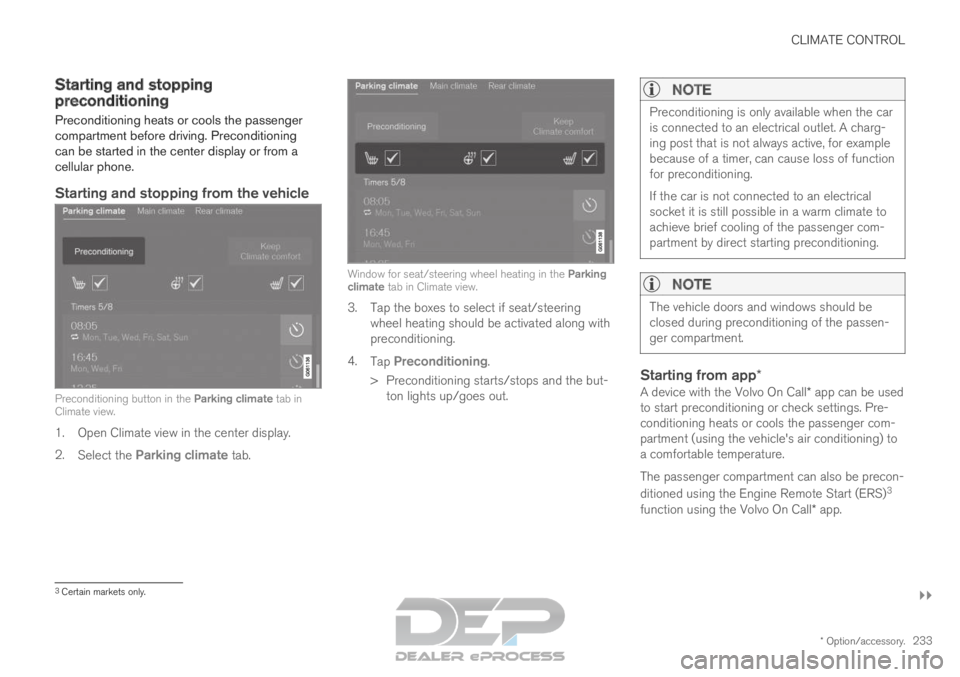
CLIMATE CONTROL
}}
* Option/accessory. 233
Starting and stopping
preconditioning
Preconditioning heats or cools the passenger
compartment before driving. Preconditioning
can be started in the center display or from a
cellular phone.
Starting and stopping from the vehicle Preconditioning button in the Parking climate tab in
Climate view.
1. Open Climate view in the center display.
2. Select the Parking climate tab. Window for seat/steering wheel heating in the Parking
climate tab in Climate view.
3. Tap the boxes to select if seat/steering
wheel heating should be activated along with
preconditioning.
4. Tap Preconditioning.
>
Preconditioning starts/stops and the but-
ton lights up/goes out.
NOTE Preconditioning is only available when the car
is connected to an electrical outlet. A charg-
ing post that is not always active, for example
because of a timer, can cause loss of function
for preconditioning.
If the car is not connected to an electrical
socket it is still possible in a warm climate to
achieve brief cooling of the passenger com-
partment by direct starting preconditioning.
NOTE
The vehicle doors and windows should be
closed during preconditioning of the passen-
ger compartment.
Starting from app*
A device with the Volvo On Call* app can be used
to start preconditioning or check settings. Pre-
conditioning heats or cools the passenger com-
partment (using the vehicle's air conditioning) to
a comfortable temperature.
The passenger compartment can also be precon-
ditioned using the Engine Remote Start (ERS) 3
function using the Volvo On Call* app. 3
Certain markets only.
Page 254 of 697

||KEY, LOCKS AND ALARM
* Option/accessory.
252
CAUTION Be sure to dispose of end-of-life batteries in
a way that protects the environment.
WARNING
California Proposition 65
Operating, servicing and maintaining a pas-
senger vehicle can expose you to chemicals
including engine exhaust, carbon monoxide,
phthalates, and lead, which are known to the
State of California to cause cancer and birth
defects or other reproductive harm. To mini-
mize exposure, avoid breathing exhaust, do
not idle the engine except as necessary, serv-
ice your vehicle in a well ventilated area and
wear gloves or wash your hands frequently
when servicing your vehicle. For more infor-
mation go to www.P65Warnings.ca.gov/
passenger-vehicle.
Related information
Remote key (p. 243) Ordering additional remote keys
Two remote keys are provided with the vehicle.
One Key Tag is also included if the vehicle is
equipped with keyless locking/unlocking*. Addi-
tional keys can be ordered.
A total of 12 keys can be programmed and used
for the same vehicle. An additional driver profile
will be added for each new remote key. This also
applies to the key tag.
Loss of a remote keyIf you lose your remote key, you can order a
replacement from a workshop - an authorized
Volvo workshop is recommended. Bring the other
remaining remote keys to the workshop. As an
anti-theft measure, the code of the lost remote
key must be erased from the system.
The current number of keys registered for the
vehicle can be checked via driver profiles in the
center display's Top view. Select Settings System Driver Profiles
.
NOTE Volvo recommends that you order a new or
duplicate remote control key from an author-
ized Volvo workshop.
You can also obtain additional or duplicate
remote control keys from certain independent
repair facilities and locksmiths that are quali-
fied to make remote control keys. Each key
must be programmed to work with your vehi-
cle.
A list of independent repair facilities and/or
locksmiths known to Volvo that can cut and
code replacement keys can be found:
on Volvo's website www.volvocars.com/us
by calling Volvo Customer Care
1-800-458-1552.
Related information
Remote key (p. 243)